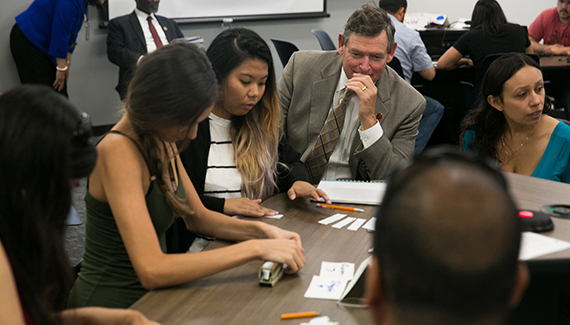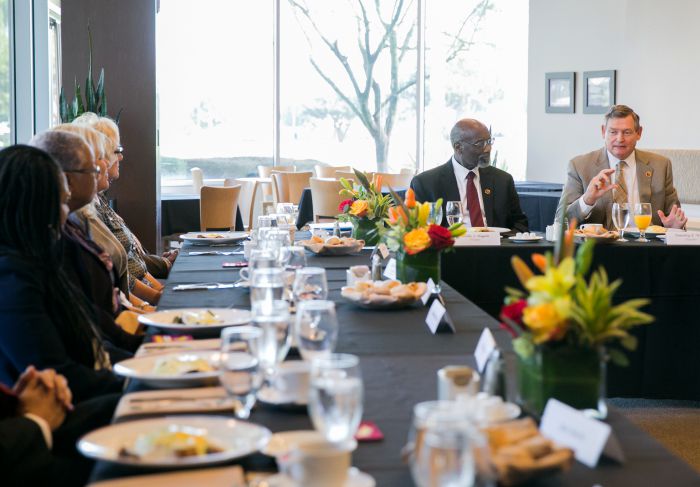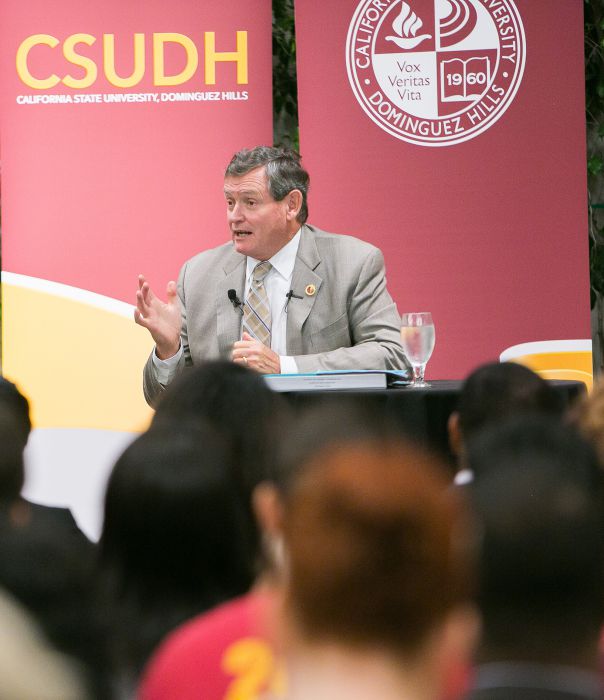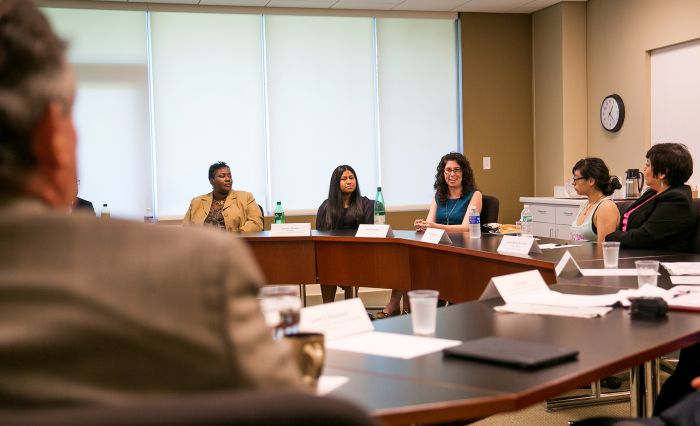
To discover how California State University, Dominguez Hills (CSUDH) is developing innovative ways to enrich the learning environment, California State University (CSU) Chancellor Timothy White spent Sept. 25 touring the university and meeting with members of the campus community.
CSUDH was the first stop in Southern California during White’s CSU system-wide tour, his second such tour since he was appointed chancellor in 2012. He spent the full day on campus with CSUDH President Willie J. Hagan meeting with prominent alumni, visiting new facilities, and engaging faculty and students involved in inventive new programs.
White, who first toured CSUDH in 2013 as the new CSU chancellor, shared the prevailing reason he frequently tours the 23 CSU campuses.

“I don’t see how I can pull the right levers in my office if I don’t have a finger on the pulse of our campuses’ existence. What I’m trying to bring to the Chancellor’s Office is a real strong commitment for all of us in the building that will enable and facilitate success on the campuses,” he said. “That is a cultural shift for us. I recognized when I came to the office that we did not have a student in the group, or a faculty member. So I realized the university doesn’t exist in my building. It exists in 23 zip codes around the state.”
White started his day with breakfast with CSUDH alumni, such as Glenn Matsushima, CEO of Prosthetic & Orthotic Group; Todd Rogers, assistant sheriff with the LA County Sheriff’s Office; Dominique Braud, post production and co-producer for the Fox TV series “The Simpsons;” Haroon Azar, regional director for strategic engagement in Los Angeles for the Department of Homeland Security; and Linda Rose, president of Los Angeles Southwest College.
He then fielded questions from faculty, students and staff during an Open Forum in the Loker Student Union ballrooms. The audience raised questions about such topics as the CSU budget and funding for new construction, as well as questions about compensation from faculty.
“For me, the quality of our people is the quality of our educational environment, which is the value of our degrees to society. So that’s why I’m working so hard to get resources from Sacramento,” White said. “We’ve been able to hold tuition flat for many years now, and we’ve been able to do some things in the last handful of years for faculty compensation as we dug out of the recession that was so debilitating to everyone in California. Your questions get us to the core of the quality of the university, which we all care deeply about. And I’m committed to finding solutions.”

Following the Open Forum, the chancellor toured the East Academic College and Small College to meet and thank staff for their commitment to the university and student achievement. He stopped by several other program offices throughout the day between scheduled meetings.
White then headed over to the new state-of-the-art Active Learning Classrooms in Welch Hall, where Thomas Norman, assistant professor of management, was teaching the upper-division course Management Theory 310.
White’s next meeting was with a gathering of faculty members and students who are enrolled in CSUDH’s new First-Year Seminar program. A re-imagining of the University 101 course for freshman, the First-Year Seminar is designed for them to experience discipline-specific lecture taught by doctoral-trained professors, much like the courses they will enroll in as upper-division students. The seminars cover a wide variety of topics, which are chosen by the professors and developed to encourage debate and student engagement during lectures and hands-on activities. White took the opportunity to ask questions and gauge their experiences regarding the pilot program.
Heather Butler, assistant professor of psychology, had several reasons for becoming a First-Year Seminar faculty member, including the opportunity to design her own curriculum for her course.
“My expertise is in cognitive bias and critical thinking, so I really like the idea of marrying that critical thinking aspect with my other line of research, which is forensic psychology,” said Butler. “The idea of creating my own critical thinking/forensics class was also fun for me, and I chose one of my biggest pet-peeves to design the course around–that a lot people learn what they know about the criminal justice system through television. I’m really enjoying exploring that and having a class where that’s the common theme.”

Freshman Laura Quirarte, an English literature student, enjoys learning during her class about the tools she can employ while reading for her course work and during her leisure time.
“I really enjoy my course because my professor talks about how to be an active reader and the value of annotation. I find that a lot of freshmen are very visual, hands-on learners,” said Quirarte. “When applying what we’ve learned in the course about annotation and the processes we can apply when reading novels, it allows us to recognize different cultures [in the reading] through all of today’s mirrors and windows, such as television, newspapers, the radio and books.”
Just prior to wrapping up his day with additional tours of campus, White shared one element of his visit that stuck with him.
“I’ve never been a fan of explaining what we do by putting antecedent words in front of things, such as ‘In light of the budget cuts…we can only do X.’ I’m a better fan of just saying ‘Let’s do X,’ because everyone has budget cuts,” said White. “If you’re always qualifying things, basically you’re making excuses for not being successful. And I think what Dominguez Hills is doing is not making excuses. Something you need [resources] isn’t always pervaded in your conversations with students and faculty, and I like that.”